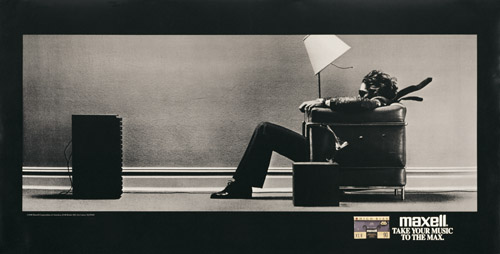(Personal note: Today marks five years since I started working at CEA, a happy and fruitful association I’m glad to acknowledge. I’ll resist the urge to elaborate on how horrifyingly quick five years can fly by. This piece, an extended appraisal of the audio industry, was the result of considerable time and attention –and love– and it seems appropriate to post it in full, throughout the week. It’s exceedingly unlikely that I’d have the opportunity to take such a deep dive into topics like this (or THIS, or THIS ) were I not including CEA in my email signature, so I remain grateful for the flexibility and freedom this venture has afforded me.)
End of an Era
Anyone not remember this iconic image?
The famous Maxell ad, now more than twenty-five years old, is not merely—and obviously—from another century, it’s a remnant of a world where analog ruled and audio was king. A world that was ostensibly less complicated, when we used to watch movies in theaters, or courtesy of paid channels on tiny CRT screens.
Flash forward two decades and the combination of digital content, including downloads and portable devices along with the ascendency of all-things video, made audio more of an afterthought. To put it mildly, this notion would have been inconceivable during the 1980’s.
Less than ten years into our new millennium the prospects for the audio category seemed dire. Even a significant economic recession failed to halt the proliferation of flat panel displays. Suddenly, it seemed, no screen size was too big and, conversely, no audio component could be small enough. Practically overnight, any consumer could conceivably store their entire sonic library into a device they could carry in their front pocket. It was revolutionary in every way, but these advancements often came at the expense of a previously impregnable home audio sector.
The question, however rhetorical, was whether or not MP3 players and earbuds comprised a whole new standard in how we listened to music. The narrative was apparent in the numbers: CD sales were down and component sales also suffered. Content was ubiquitous but (increasingly) free, and sound quality, often spotty at best, seemed a peripheral concern. The notion of whether or not the audiophile—the guy from the Maxell ad—was a relic from the past seemed settled: that dude was a dinosaur, a symbol of the bad old days a new generation would never feel especially nostalgic about.
Requiem for the Audiophile
If you are a certain age you can easily envision the person. Perhaps you were that person: the one who not only had to own the latest and most advanced high-end equipment, but also proselytized about the components, compelled to convert friends and acquaintances. Perfection carried a price tag; the naysayers might be able to listen to the sounds, but they weren’t really hearing them, etc.
As difficult as it likely is for younger consumers to appreciate or even conceive, the playing field for home audio remained relatively uncomplicated for the better part of a century. After record players were challenged by cassette decks (the less said about 8-Tracks the better) which in turn were supplanted by CD players, it remained a two-channel environment, all powered by a receiver and a set of speakers.
This landscape changed gradually but the eventual paradigm shift—made inevitable by the Internet—was radical and, today, seems permanent. The electrical storm of digital files and the advent of MP3 players made the consumption of audio content not unlike personal computing: a 24/7, multi-location proposition. People were able to take their music with them wherever they roamed; gradually a concept that seemed exceptional became compulsory.

